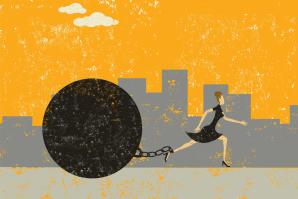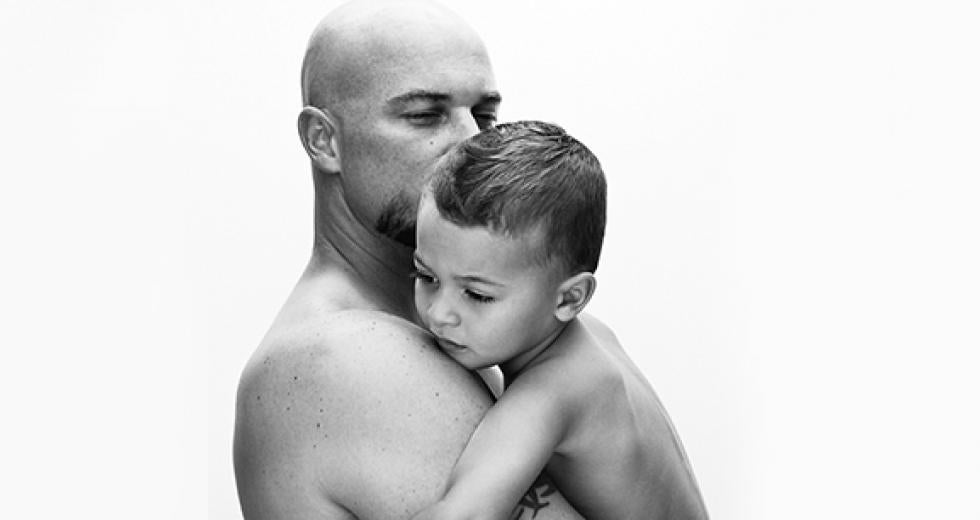On opening day of the 2014 baseball season, New York Mets second baseman Daniel Murphy was noticeably absent. He wasn’t benched. He didn’t have the flu. He simply took advantage of Major League Baseball’s paternity leave policy, which grants 72 hours off, to attend the birth of his son.
And all hell broke loose.
“You’re a Major League Baseball player. You can hire a nurse!” chided one radio talk show host. “What are you gonna do, sit there and look at your wife in the hospital bed for two days?” Former quarterback Boomer Esiason suggested Murphy’s wife should have scheduled a “C-section before the season starts.”
Esiason is 53 years old. Murphy is 29. One is a boomer, the other a millennial, and together they neatly encapsulate the evolving views on paternity leave. More and more dads are taking time off, especially in California, but many still feel guilty, as if they’re not doing the “manly” thing of sticking it out in the office. New research suggests the world needs more Daniel Murphys, as paternity leave has surprising benefits to corporations, fathers, mothers and possibly the economy as a whole.
Good Dads = Happy Workers
Reason No. 567 why it’s good to live in California: Thanks to the Paid Family Leave Act of 2002, new dads are eligible for six weeks of partially paid paternity leave, funded by the state through a small payroll tax. (Only New Jersey, Washington and Rhode Island have similar policies.) Some companies go above and beyond. In Ernst & Young’s Roseville office, for example, after one year of service, new dads can up to take six weeks of fully paid paternal leave on top of what they get through the state.
That sort of generosity can prove to be a useful retention tool. “If you want loyal employees, flexibility and paternity leave is a way to help the employee and make it more likely they stick around and feel more committed to your company,” says Dr. Scott Behson, a professor of management at New Jersey’s Fairleigh Dickinson University, who runs the blog fathersworkandfamily.com. It’s a signal that when it comes to that magical corporate unicorn of work/life balance, your company actually walks the walk.
Take Erik Hosino, 33, a graphic designer who works in VSP Global’s Sacramento office. He took nearly a month off. “I wanted to be able to help my wife, who I knew would be recovering from child birth,” he says, adding that his friends were mostly supportive and maybe even a little regretful that they didn’t do the same. “But mostly it was about bonding with my new son and letting him know who his people are.”
Not only does it help the father bond with his child, it helps him, arguably, bond with the workplace.
Ernst & Young’s Inclusiveness Officer Karyn Twaronite says that after surveying its 175,000 employees, it found that “the firm’s working parents expressed the highest levels of engagement among all professionals.” Twaronite attributes this to both the paternity leave and an overall culture of family-friendliness. “Our men increasingly value day-to-day flexibility,” she says.
That said, paternity leave can be one of those benefits that looks great on the company brochure but is hard to put into practice, says Kris Dunn, who runs the human resources blog hrcapitalist.com. “You can say you offer it — and even kick something in for the dads — and most of them are going back to work in a week or two.”
The data backs this up. According to a 2011 study of Fortune 500 companies from the Boston College Center for Work and Family, 76 percent of men take less than a week off. It’s just not part of our culture. In a global 2013 study from the Pew Research Center, of 38 countries surveyed, the United States ranks dead last in federally mandated paid paternal care.
Jennifer Berhdal, professor at the University of Toronto’s Rotman School of Management, studied the family and workplace attitudes of blue-collar workers and found that many dads felt “harassed” or “teased” when they were the primary caregiver. Call it the “Mr. Mom syndrome.” It’s a residue of “outdated cultural assumptions that the workplace is where the man belongs,” theorizes Brian Gresko on parenting site babble.com. “Even if the father doesn’t feel this way himself, his boss or colleagues might.” Consciously or subconsciously, we might wonder … Will I look like a sissy for changing diapers while my wife heads to the office?
This Don Draper-esque mindset lags behind the new reality of gender roles, where 40 percent of households have women as the sole or primary earner. “Attitudes are slowly changing, but not as much as you’d expect considering how family structures have changed,” says Dr. Behson. “Many workplaces still have expectations that there’s a breadwinner dad and a caretaker mom.”
The Surprising Upside for Women
This needs to change. More is at stake than just the male ego. “The biggest beneficiaries aren’t men, or even babies,” argues Liza Munday in The Atlantic, who made possibly the most forceful case yet for paternity leave. “In the long run, the true beneficiaries of paternity leave are women and the companies and nations that benefit when women advance.” Munday’s research shows that when men take off work to care for their babies, they develop nurturing habits that stick with them for life. This takes pressure off their partners, who are then more comfortable going back to the office. Everyone wins.
Fa Karamzadeh, 35, with his two-year-old son, Hudson

A friend of mine, Steve, is a New York lawyer. So is his wife. When expecting their first child, he had originally planned to take a full five weeks of paternity leave: two weeks (paid) for the birth of their son plus one week of paid vacation, and then, months later, two more weeks (unpaid) to cover at home while his wife reacclimated to the workplace. “It’s a small firm, so they were basically developing their paternity policy on the fly,” Steve told me. They granted the first three weeks of paid leave, but balked at his request for the two additional weeks — even though he was willing to do it unpaid. Let’s let that sink in: his wife, a lawyer, could take five months of paid maternity leave (plus one unpaid) without anyone blinking, but if he, a man, wanted to take two weeks of unpaid leave to assist with the baby, this raised eyebrows. They compromised on one week of unpaid leave. “To tell you the truth, that one week was hard, and I’m not sure I could handle two,” he says, laughing. “It gave me a new appreciation for what she was going through.”
Paternity leave can make for better dads and better partners, and this, in turn, lets moms get back to lawyering. My friend now splits the diaper duty, makes the breakfasts (not just cereal, but sausage), and the two take turns getting home early from work. He’s all-in. When Steve ran into another friend with a baby the same age, he was surprised that the other dad didn’t know how to put the baby down for a nap. Steve had been doing that for months.
This is the benefit of paternity leave. After interviewing 85 fathers and partners, Dr. Erin Rehel, a Canadian sociologist, found that it helps dads shift from a “manager-helper dynamic” to that of true co-parenting, which creates “opportunities for a more gender-equitable division of labor,” as she told AOL. When dads are there from the get-go, they “really understand what it means to take care of an infant, all the things that go into a daily routine.” They also said it brought them closer to their partners. There’s no data on this, and not enough time has passed, but we shouldn’t be surprised if paternity leave correlates with lower divorce rates, too.
Here’s why all this matters at the office: The gender pay gap still exists; on average, women are paid 77 cents to every dollar earned by men. And the root of this gap, argues Hannah Rosin from Slate, isn’t craven sexism, but rather the career disruptions caused by maternity. She cites a study from economists Claudia Goldin and Lawrence Katz, who analyzed the pay differentials of MBA graduates over a 16-year period. They found that when they scored their first job, there was “only a tiny differential in salary between men and women,” but over the next decade, “the gap widens to 40 percent, almost all of which is due to career interruptions and fewer (work) hours.” So if we want to narrow the gap, we need to change the structural forces that — however well-intentioned — nudge women from the workplace.
What’s good for women is good for the overall economy. The World Economic Forum, which tracks global trends and wage disparities, found a link between a nation’s competitiveness and closing the gender gap. The group’s logic is straightforward enough: “Because women account for one-half of a country’s potential talent base, a nation’s competitiveness in the long term depends significantly on whether and how it educates and utilizes its women.” And our “utilization” can use a shot in the arm: Pew Research shows that after a 30-year decline in the percentage of stay-at-home-moms, we’ve ticked back up in the past decade. Twenty-nine percent stayed home in 2012, up from 23 percent in 1999. Paternity leave could help buck the trend.
How to Make It Happen
It would be naive and counterproductive to pretend that paternity leave never causes problems. It can and it does. “It can be a hardship on the employer if the workplace is small. If you have two or three people, losing someone can be tough,” says Julie Worley, president elect of the Sacramento Area Human Resource Association. (Quick clarification: The size of the company matters. Technically, all employees with state disability insurance can get the six weeks of paid leave. But the 12 weeks of protected unpaid leave, guaranteed through the Family and Medical Leave Act, only applies to companies with 50 employees or more.) “Even if the company is larger, it can still be a source of frustration. Let’s say you have five writers on a team — somebody has to pick up that extra week.” Perhaps for this reason, Worley and her colleagues aren’t aware of many local companies that give more than the state-mandated guidelines. Ernst & Young is the exception, not the rule.
But here’s the thing: Those same office headaches exist for maternity leave, too. Paternity leave just spreads the pain more evenly across the genders. Companies are starting to embrace this. At VSP, for example, Hosino (the new dad) said he felt nothing but encouragement. “VSP was incredibly supportive. My co-workers had to pick up the slack when I was out, but on my last day, everyone pushed me out the door and said, ‘Congratulations!’”
So how can we get more to follow his lead? When Ernst & Young first offered paternity leave, “there was a misperception that men would never take it,” says Twaronite. They made sure that senior managers talked about it, championed it, pushed people to take it. And they did. “Now the conversation today is not about if men are going to take leave, it’s about how long.” They did more than just slap it on a brochure. In 2012 they started “executive coaching for new dads, offering individual and group sessions to help dads before and after childbirth.” The results? Roughly 600 E&Y employees take paternity leaves each year, which is, remarkably, about the same as the number of women who take maternity leaves. Progress.
We can also learn from other nations that are getting it right. As Munday reports, countries like Norway, Iceland, Germany and Finland are effectively paying dads to go back home, making them feel like chumps if they leave the money on the table. They “offered [dads] more money, which helped men feel that they were financially supporting their families even when they were at home.” In Quebec, for instance, they bumped the amount of fully paid paternity leave to five weeks and saw the percentage of men taking it jump from 10 percent in 2001 to 80 percent in 2010.
We likely won’t be doing that anytime soon. But we can take some comfort in knowing that while Boomer Esiason was harping on Daniel Murphy for taking three days off, according to Dr. Behson, “90 percent of sports fans supported Murphy’s decision.” More progress.
There are 162 games in a baseball season. In his career, Murphy has played more than 600 games and will likely play hundreds more. He has one son. Just as with all of us, work will always be there on Monday morning. But as Hosino says, “In three months, six months, 10 years down the road, you’re not going to remember the work you rushed back to get done, but you will remember those first memories with your baby.”
Recommended For You

The Motherhood Penalty
Don't let parenthood stand in the way of pay raises and promotions
For women who fear facing financial or career penalties while parenting, it is important to be proactive. As with all career goals, the key is setting realistic expectations and communicating them effectively to others.

Million-Dollar Babies
Starting a family needn’t push retirement out of reach
Michael and Susan Pope had witnessed enough of parenthood to give them second thoughts about having children of their own. After seeing friends vanish into an abyss of diaper bags, sleepless nights, stress, arguments and the apparent loss of every conceivable freedom, they had plenty of reasons to reconsider.

Mini Moguls
More youth are reaping the rewards and lessons of entrepreneurship
While browsing in a shop in 2009, 6-year-old Allison Prestwich saw a candle made by the Tyler Candle Co., and she wondered aloud if it was named after her younger brother.

Million-Dollar Maybe
Why so few women-owned businesses hit seven figures
Today, there are more than 8 million women-owned businesses in America, generating nearly $1.3 trillion in annual revenue. Women continue to launch enterprises at a faster rate than the national average, according to the latest Census data. In fact, women have been launching and growing businesses faster than men for the past two decades.



